Contact:
Lane Smith, Research Program Coordinator, NYSG, E: lane.smith@stonybrook.edu, P: (631) 632-9780
Stony Brook, NY, August 9, 2022 - Here are some summaries for ongoing investigations that address a variety of concerns within a few key topics, including:
(a) Coastal Ecosystems — (1) Expanding test cases to determine how efficient sugar kelp is at soaking up nitrogen and phosphorus from the water; (2) Examining the potential impacts microplastics can have on the ecosystem services in Great Lakes sediments.
(b) Fisheries — Zooming in on faster-growing oysters, which may be desirable for aquaculture farmers because it means less exposure to disease and a higher yield.
(c) Coastal Resiliency — (1) Amassing data to help communities apply for assistance through The New York Climate Smart Communities Program; (2) Gathering information that will allow for improved prediction of bluff erosion that informs planning by coastal communities.
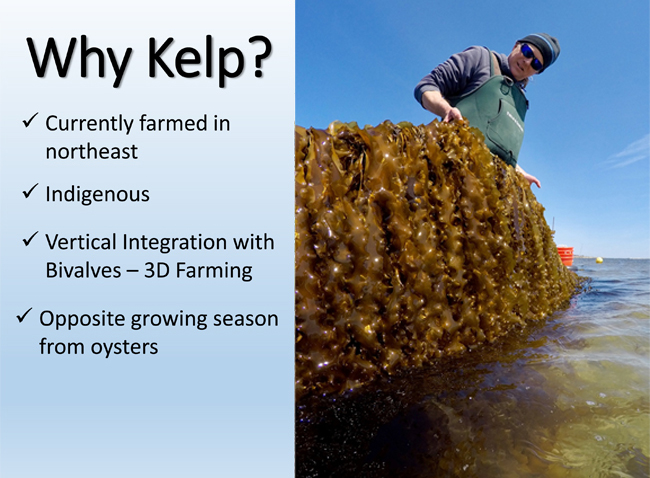
Mike Doall showing kelp grown at Great Gun Shellfish on Moriches Bay in East Moriches. Sugar kelp, a brown rubbery plant that can grow underwater fronds 15 feet long, is proving in test cases, the researchers say, to be highly efficient at soaking up nitrogen and phosphorus from the water. Credit: Micahel Doall
The Use of macroalgae to Expand Aquaculture and Prevent, Control, and Mitigate Harmful Algal Blooms in New York’s Coastal Zones (R/ATD-14, Dr. Christopher Gobler, Stony Brook University)
For the past several decades New York’s coastal waters have undergone an increase of human-caused nutrient loading that have contributed to many serious and diverse Harmful Algal Blooms (HABs). These blooms have had severe ecosystem and economic impacts. A variety of efforts have been engaged to reduce the severity and consequence of HABs. Studies in Asia have shown that many species of macroalgae can inhibit the growth of and potentially kill a broad range of microalgae, including multiple HAB species.
A research project led by Dr. Chris Gobler of Stony Brook University is examining the link between HABs and macroalgae aquaculture. The project aims to assess the ability of cultivable macroalgae species to inhibit the growth of HAB species common to NY waters. The research team will conduct experiments to assess the effects of macroalgae on HABs and shellfish, and assess the feasibility of co-culturing HAB-combative seaweeds with shellfish at shellfish farms.
The expected result of the project is the development of seaweed cultivation best practices and guidance materials. Progress so far has demonstrated the HAB inhibiting effects of the sugar kelp, Saccharina latissima, on the okadaic acid producing dinoflagellate, Dinophysis acuminate and the saxitoxin producing dinoflagellate, Alexandrium catenella. Field cultivation techniques developed to co-culture HAB-combative seaweeds with bivalve shellfish are being assessed at commercially viable scales on Long Island at 10 oyster farms.
More:
Reporting Suspicious Marine Algal Blooms
On YouTube: HABs A Summer of Discontent in Long Island's Coastal Waters (October 2021)
In Photos, On YouTube: State of the Bays — 2021 (July 2021)
In Media: Cultivating Kelp Will Help Cut Down Nitrogen in Local Waters (June 2021)
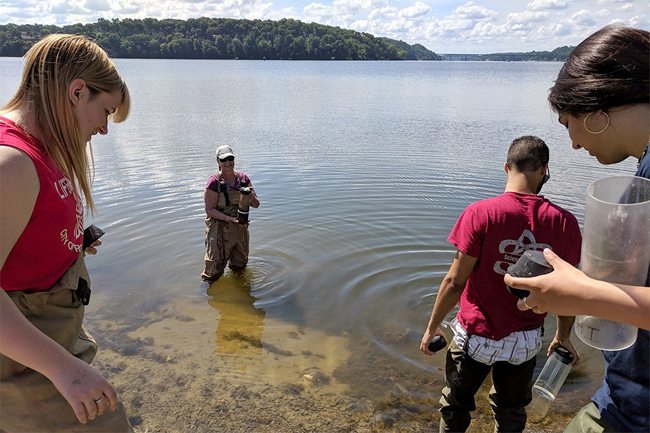
RIT Associate Professor Christy Tyler (center) collects sediment samples in Irondequoit Bay in 2019. The team, using Lake Ontario as its case study, is examining the potential impacts microplastics can have on the ecosystem services in Great Lakes sediments. Credit: Matthew Hoffman/RIT
Impacts of Microplastic Pollution on Benthic Ecosystem Functions and Services (R/CTP-55, Dr. Christy Tyler, Rochester Institute of Technology)
Microplastic pollution has been found in diverse marine, freshwater, and terrestrial ecosystems. The scientific consensus is that plastic debris impacts aquatic systems at all levels of biological organization.
The majority of existing microplastic research focuses on oceans or the open water zones of lakes. Though there are relatively high concentrations of plastics found in freshwater sediments, the data are sparse. Questions remain regarding the potential impacts of microplastics upon sediment ecosystem processes. There is insufficient spatial and temporal resolution of plastic debris quantity and quality in the Great Lakes to effectively inform policy, mitigation, management strategies, and the design of targeted research.
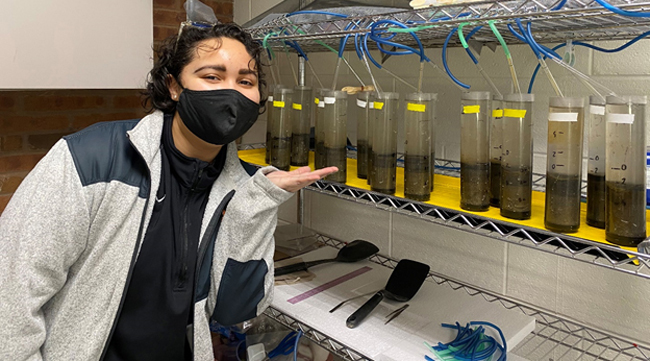
Undergraduate student Raquel Diaz standing next to a sediment experiment setup in Tyler’s laboratory. Credit: Christy Tyler
A research team at Rochester Institute of Technology led by Dr. Christy Tyler aims to address this knowledge gap by combining sediment sample analysis with three-dimensional transport modeling to produce the first estimates of polymer-specific plastic flux to the sediment.
Progress so far for the project includes updates to hydrodynamic models to assess plastic transport in the Lake to include both three-dimensional transport and polymer-specific settling rates. The model output suggests that debris is transported and deposited in the nearshore region of the lake, with rates dependent on material properties. A simplified version of the model is on a webpage (www.lakeontarioplastic.org) for both educational outreach and simple scenario testing. Work continues on chemical degradation, biofilm formation, toxicity and impact on ecosystem function of microplastics.
More:
$2.1 Million Awarded for Sea Grant Research on NY’s Coastal Environment, Communities & Aquaculture (October 2020)
In Media: RIT researchers receive grant to study microplastic pollution in Lake Ontario (May 2020)
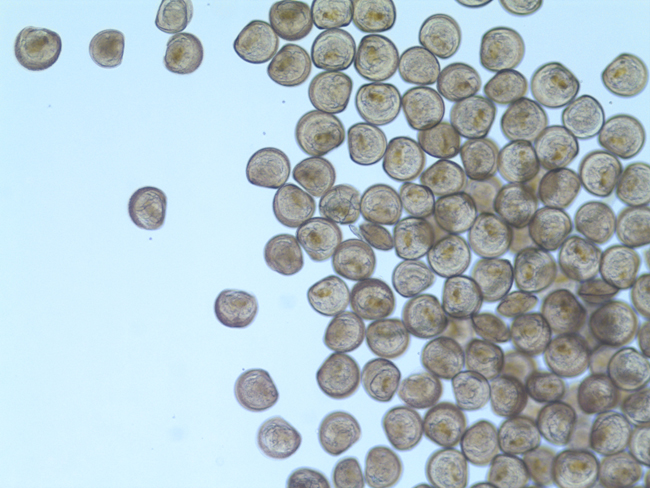
Researcher Bassem Allam says that a faster-growing oyster (seen here in its larval stage) can be desirable for farmers because it means less exposure to disease and a higher yield. Some studies, he said, have reported up to a 70% to 80% higher yield. But, not all oyster researchers have had that luck. Allam said that in some places in the nation, colleagues have reported unusually high mortalities in their triploid oysters. “It is unclear why that occurred and it is not the case everywhere, but if that does happen in our research, we will attempt to understand the reasons behind it,” said Allam. Credit: Caroline Schwaner
Identification of Superior Diploid and Triploid Oyster Lines for Aquaculture Operations in New York (R/XG-33, Dr. Bassem Allam, at Stony Brook University)
Oyster aquaculture represents a sustainable, environmentally-friendly industry that contributes to the economic growth of local coastal communities. Many factors affect success in general and oyster aquaculture remains a risky business. This is particularly true for the eastern oyster where disease pressure represents a main factor affecting success.
To help overcome this risk, a research team led by Dr. Bassem Allam, at Stony Brook University is conducting a study comparing the performance of different oyster lines derived from different genetic backgrounds. The team will contrast the performance of locally-derived triploid oysters with that of their diploid counterparts.
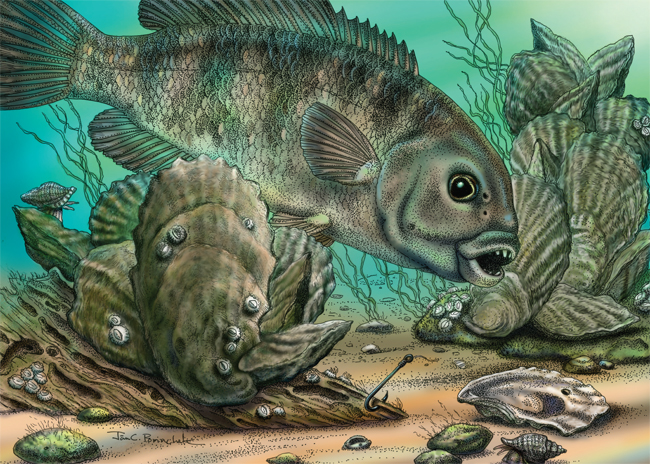
Oyster reefs were once a dominant feature of estuaries along the Atlantic and Gulf of Mexico coasts with healthy communities of eastern oyster. NY Sea Grant-supported research is providing information to support oyster restoration efforts in NY/NJ harbor. Credit: Jan Porinchak
Triploid oysters grow fast and maintain high meat quality throughout the year, significantly enhancing yield from a given farm. The research team has produced 9 oyster lines so far and used them in a series of field and lab experiments to evaluate the resistance of each line to bacterial pathogens, assess growth, disease prevalence and survivorship.
Results generated so far show a better resistance of diploid larvae and juvenile oysters to bacterial pathogens as compared to triploids. In contrast, preliminary analysis of data collected in 2021 indicate that yield was superior for triploid oysters.
More:
Molecular Adaptation and Selection in Oysters (May 2022)
$2.1 Million Awarded for Sea Grant Research on NY’s Coastal Environment, Communities & Aquaculture (October 2020)
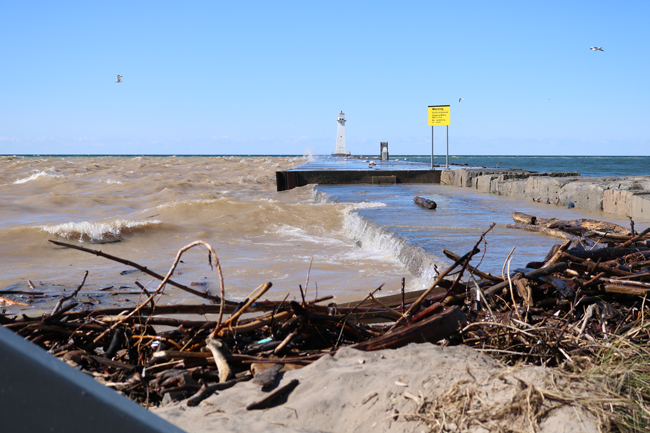
Record level flooding has been a challenge for coastal communities along Lake Ontario. A NYSG-supported study is providing information that will help communities apply for assistance through The New York Climate Smart Communities Program. Credit: Mary Austerman/NYSG
Using Hydroclimate Modeling and Social Science to Enhance Flood Resilience on Lake Ontario Through the Climate Smart Communities Program (R/CHD-15, Dr. Scott Steinschneider, Cornell University)
The New York Climate Smart Communities (CSC) Program is a New York State program that helps local governments adapt to a changing climate. Part of the program offers competitive grants with 50% matching funds for projects to improve the resilience of coastal communities, however, participation in the program among Lake Ontario municipalities, recently impacted by several flooding events, is low, in part because of the requirement for municipalities to demonstrate the need for a project based on an assessment of future conditions derived from scientifically supported climate projections.
A research project led by Dr. Scott Steinschneider of Cornell University in partnership with the Genesee/Finger Lakes Regional Planning Council, is developing and integrating modeling tools and social-science based recommendations to help Lake Ontario coastal communities better meet the CSC Program requirements and adapt to future coastal flooding.
The research team has finalized and validated an integrated modeling framework of Lake Ontario hydrology, water level management, and flood inundation that can be used to project future flood risk around the lake. Work continues on social science to better understand the range of specific information needed to support effective Climate Smart Communities (CSC) applications, as well as other factors influencing participation in the CSC program and use of modeling tools.
More:
$2.1 Million Awarded for Sea Grant Research on NY’s Coastal Environment, Communities & Aquaculture (October 2020)
NY Sea Grant and Cornell Professor Introduce Lake Ontario Parcel-Level Flood Risk Prediction Tool (August 2020)
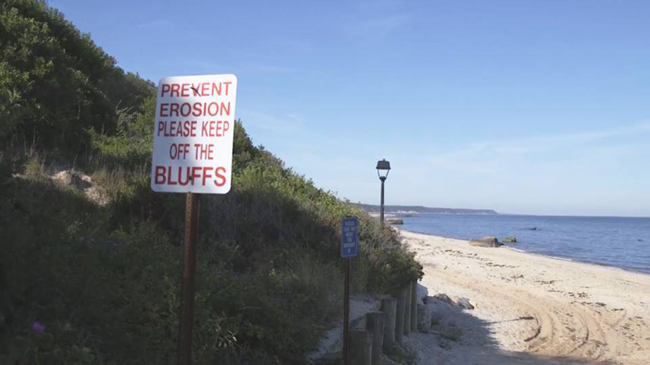
In an effort to help prevent erosion, signage encourages beachgoers to keep off coastal bluffs. A NYSG-funded project is gathering information that will allow for improved prediction of bluff erosion that informs planning by coastal communities. Credit: Cornell Extension Marine Program
Erosion and Recession of Coastal Buffs: Characterizing Erodibility of Bluff Materials Under Various Land- and Sea-Based Conditions (R/CCP-20, Dr. Ali Farhadzadeh, Stony Brook University)
Bluff erosion and recession from rising sea levels, elongated droughts, heavier rainfall, and coastal storms poses substantial risks to the safety of nearby houses, infrastructure, and coastal ecosystems.
A research team, led by Dr. Ali Farhadzadeh at Stony Brook University, aims to test the hypothesis that in addition to sea-based processes, variations in bluff recession rate is significantly influenced by variations in soil erodibility. The research team is studying the soil characteristics of bluffs in the Great Lakes and Montauk Point, Long Island to understand the processes underlying erosion of cohesive beaches and the failure of coastal bluffs due to extreme events. This research will be incorporated into an improved model tailored to both Long Island and the Great Lakes. The developed model could be used for more accurate predictions of coastal bluff recession and to identify risk areas where shoreline protection measures could prevent or slow further recession.
The results will be useful for resource managers and property owners to better predict and respond to future erosion under varying climate changes. Bluff materials collected so far have been used in small scale flume experiments and larger scale experiments are planned.
More:
$2.1 Million Awarded for Sea Grant Research on NY’s Coastal Environment, Communities & Aquaculture (October 2020)
Omnibus 2020-21 Research Project Discussion: Erosion and Recession of Coastal Bluffs (August 2020)
Kathleen Fallon Shares Coastal Erosion Information with Long Islanders (March 2018)
On YouTube: Don’t Be Blind to Signs of Shoreline Bluff Erosion (July 2017)
More Info: New York Sea Grant
New York Sea Grant (NYSG), a cooperative program of Cornell University
and the State University of New York (SUNY), is one of 34 university-based
programs under the National Oceanic and Atmospheric Administration’s
National Sea Grant College Program.
Since 1971, NYSG has represented a statewide network of integrated
research, education and extension services promoting coastal community
economic vitality, environmental sustainability and citizen awareness
and understanding about the State’s marine and Great Lakes resources.
Through NYSG’s efforts, the combined talents of university scientists
and extension specialists help develop and transfer science-based
information to many coastal user groups—businesses and industries,
federal, state and local government decision-makers and agency managers,
educators, the media and the interested public.
The program maintains Great Lakes offices at Cornell University, SUNY
Buffalo, SUNY Oswego and the Wayne County Cooperative Extension office
in Newark. In the State's marine waters, NYSG has offices at Stony Brook
University in Long Island, Brooklyn College and Cornell Cooperative
Extension in NYC and Kingston in the Hudson Valley.
For updates on Sea Grant activities: www.nyseagrant.org has RSS, Facebook, Twitter, Instagram, and YouTube links. NYSG offers a free e-list sign up via www.nyseagrant.org/nycoastlines for its flagship publication, NY Coastlines/Currents, which is published quarterly.